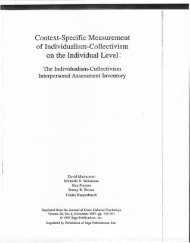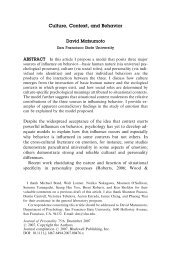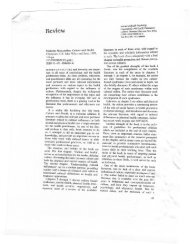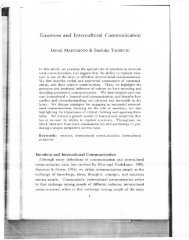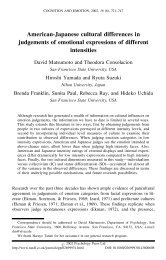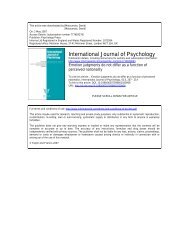Journal of Cross-Cultural Psychology - David Matsumoto
Journal of Cross-Cultural Psychology - David Matsumoto
Journal of Cross-Cultural Psychology - David Matsumoto
Create successful ePaper yourself
Turn your PDF publications into a flip-book with our unique Google optimized e-Paper software.
<strong>Journal</strong> <strong>of</strong> <strong>Cross</strong>-<strong>Cultural</strong> <strong>Psychology</strong><br />
http://jcc.sagepub.com/<br />
<strong>Cultural</strong> Differences in the Relative Contributions <strong>of</strong> Face and Context to Judgments<br />
<strong>of</strong> Emotions<br />
<strong>David</strong> <strong>Matsumoto</strong>, Hyi Sung Hwang and Hiroshi Yamada<br />
<strong>Journal</strong> <strong>of</strong> <strong>Cross</strong>-<strong>Cultural</strong> <strong>Psychology</strong> published online 15 December 2010<br />
DOI: 10.1177/0022022110387426<br />
The online version <strong>of</strong> this article can be found at:<br />
http://jcc.sagepub.com/content/early/2010/12/14/0022022110387426<br />
Published by:<br />
http://www.sagepublications.com<br />
On behalf <strong>of</strong>:<br />
International Association for <strong>Cross</strong>-<strong>Cultural</strong> <strong>Psychology</strong><br />
Additional services and information for <strong>Journal</strong> <strong>of</strong> <strong>Cross</strong>-<strong>Cultural</strong> <strong>Psychology</strong> can be found at:<br />
Email Alerts: http://jcc.sagepub.com/cgi/alerts<br />
Subscriptions: http://jcc.sagepub.com/subscriptions<br />
Reprints: http://www.sagepub.com/journalsReprints.nav<br />
Permissions: http://www.sagepub.com/journalsPermissions.nav<br />
Downloaded from<br />
jcc.sagepub.com by DAVID MATSUMOTO on December 15, 2010
<strong>Cultural</strong> Differences in<br />
the Relative Contributions<br />
<strong>of</strong> Face and Context to<br />
Judgments <strong>of</strong> Emotion<br />
<strong>David</strong> <strong>Matsumoto</strong> 1 , Hyi Sung Hwang 1 ,<br />
and Hiroshi Yamada 2<br />
<strong>Journal</strong> <strong>of</strong> <strong>Cross</strong>-<strong>Cultural</strong> <strong>Psychology</strong><br />
XX(X) 1 –21<br />
© The Author(s) 2010<br />
Reprints and permission:<br />
sagepub.com/journalsPermissions.nav<br />
DOI: 10.1177/0022022110387426<br />
jccp.sagepub.com<br />
Abstract<br />
Previous judgment studies <strong>of</strong> facial expressions <strong>of</strong> emotion in context have provided mixed<br />
results. This article clarifies and extends this literature by testing judgments across cultures and<br />
by using novel methodologies that examine both face and context effects. Two studies involving<br />
observers from three cultures provided evidence for both face and context effects in emotion<br />
judgments and cultural differences in both. Japanese and South Korean observers were more<br />
influenced by context than Americans, and these differences were mediated by personality<br />
traits. The results provided a more nuanced view <strong>of</strong> how both culture and emotion moderate<br />
judgments <strong>of</strong> faces in context and how cultural differences existed in the judgments, which were<br />
predicted using a construct known as Context Differentiation.<br />
Keywords<br />
culture, emotion, context, response linkage, face superiority, context superiority<br />
Facial expressions occur in context in real life, and the relative importance <strong>of</strong> face and context in<br />
contributing to emotion messages has been debated for years (Bruner & Tagiuri, 1954; Ekman &<br />
O’Sullivan, 1988; Fernberger, 1928; Russell & Fehr, 1987). Studies in this area, which typically<br />
obtain emotion judgments <strong>of</strong> congruent and incongruent face-context combinations, have produced<br />
inconsistent results. Some have reported context superiority (Carroll & Russell, 1996;<br />
Fernberger, 1928; Russell & Fehr, 1987); others face superiority (Ekman & O’Sullivan, 1988;<br />
Ekman, O’Sullivan, & <strong>Matsumoto</strong>, 1991; Frijda, 1969; Goldberg, 1951; Nakamura, Buck, &<br />
Kenny, 1990). Some provided no support for either (Fernandez-Dols, Sierra, & Ruiz-Belda,<br />
1993; Goodenough & Tinker, 1931; Munn, 1940; Vinacke, 1949), while some have supported an<br />
additive hypothesis (Aviezer et al., 2008; Bruner & Tagiuri, 1954; Knudsen & Muzekari, 1983;<br />
Meeren, van Heijnsbergen, & de Gelder, 2005).<br />
1 San Francisco State University, San Francisco, California, USA<br />
2 Nihon University, Tokyo, Japan<br />
Corresponding Author:<br />
<strong>David</strong> <strong>Matsumoto</strong>, Department <strong>of</strong> <strong>Psychology</strong>, San Francisco State University,<br />
1600 Holloway Avenue, San Francisco, CA 94132.<br />
Email: dm@sfsu.edu<br />
Downloaded from<br />
jcc.sagepub.com by DAVID MATSUMOTO on December 15, 2010
2 <strong>Journal</strong> <strong>of</strong> <strong>Cross</strong>-<strong>Cultural</strong> <strong>Psychology</strong> XX(X)<br />
One reason for these inconsistencies may be the blending <strong>of</strong> different research paradigms.<br />
Contexts in which expressions occur have many characteristics, including the faces that occur<br />
before or after a target face, faces that occur in other people around a target person, other cues in<br />
the face or head area (e.g., hairstyle, glasses, facial hair), other cues in body postures and gestures,<br />
who else is involved, the physical setting, the nature <strong>of</strong> the emotion trigger, or words associated<br />
with the expressions. 1 Consequently, studies have varied as well; faces have been combined<br />
with knowledge about what triggered an emotion (Ekman, Friesen, & Ellsworth, 1972; Fernandez-<br />
Dols et al., 1993; Frijda, 1969; Goodenough & Tinker, 1931; Knudsen & Muzekari, 1983), other<br />
bodily responses (Aviezer et al., 2008; Meeren et al., 2005), other faces seen prior to a target<br />
emotional expression to be judged (Carroll & Russell, 1996; Ekman et al., 1991; Goldberg, 1951;<br />
Russell & Fehr, 1987), and different angle shots that include more information (Munn, 1940;<br />
Vinacke, 1949; for a more detailed description <strong>of</strong> the differences among these paradigms and<br />
their implications to real life phonemena, see <strong>Matsumoto</strong> & Hwang, 2010). This article is concerned<br />
with judgments <strong>of</strong> congruent and incongruent combinations <strong>of</strong> facial expressions <strong>of</strong> emotion<br />
with the events that triggered them, which we term response linkage.<br />
Response Linkage<br />
Response linkage refers to the connection between an emotion-eliciting event and the subsequent<br />
response to it. Emotions are linked to events because they are evolutionarily based, informationprocessing<br />
programs (Levenson, 1999; Tooby & Cosmides, 2008) that reliably connect an event<br />
with a behavioral response that aids in adaptation. Linking spoiled milk with disgust, growling<br />
sounds at night with fear, death with sadness, and experiences with loved ones with happiness are<br />
all important functions <strong>of</strong> emotions that aid in adaptation to the world and ultimately survival.<br />
Response linkages may be congruent or incongruent. Congruent linkages occur when an event<br />
that elicits an emotion in most people is associated with that emotion’s response components<br />
(expressive behavior, physiology) in the people experiencing the event. Congruent linkages may<br />
occur because humans come preprogrammed to have certain emotions to certain events (Mineka<br />
& Cook, 1993; Ohman & Mineka, 2003) or because <strong>of</strong> culture-constant learning. Incongruent<br />
response linkages occur when an event that elicits an emotion in most is associated with a different<br />
emotional response. These can occur either through individual or cultural differences in learning<br />
which emotions to link to which events or in the rules <strong>of</strong> modulating emotional responses (display<br />
rules; Ekman & Friesen, 1969). Thus, a smiling face in an event that elicits happiness in most<br />
people would be congruent; an angry face in that same event, however, would be incongruent.<br />
Judgment studies <strong>of</strong> response linkages are important because they inform us <strong>of</strong> how emotions<br />
are judged in relatively more realistic contexts as opposed to the fairly acontextual way<br />
most studies have been conducted (Biehl et al., 1997; Ekman et al., 1987). When faces are presented<br />
acontextually, recognition rates are high and statistically significant, but generally never<br />
near perfect (with the exception <strong>of</strong> high-intensity smiles). Studies involving congruent response<br />
linkages would predict an additive effect on judgments because <strong>of</strong> the increased signal clarity<br />
in the overall emotion message when two different signal sources provide the same message.<br />
This is what previous mono-cultural studies have found (Bruner & Tagiuri, 1954; Knudsen &<br />
Muzekari, 1983).<br />
Incongruent response linkage occurs because <strong>of</strong> learned emotional responding or response<br />
regulation in the first place; thus, judgment studies <strong>of</strong> them may reflect the biases associated with<br />
that learning. When viewing a happy face in a situation that normally would elicit anger, for<br />
instance, judges may infer that the happy face is a mask (learned) that hides the expresser’s true<br />
feelings and may judge the person to be angry despite smiling. In this case, the judgment <strong>of</strong> anger<br />
Downloaded from<br />
jcc.sagepub.com by DAVID MATSUMOTO on December 15, 2010
<strong>Matsumoto</strong> et al. 3<br />
is made on the basis <strong>of</strong> an attribution <strong>of</strong> the smile as a learned mask, and not as a signal <strong>of</strong> true<br />
enjoyment. Still, previous studies have demonstrated a face superiority effect, indicating that the<br />
signals in the face tend to override the signals provided by the context (Ekman & O’Sullivan, 1988;<br />
Ekman et al., 1991; Frijda, 1969; Goldberg, 1951; Nakamura et al., 1990).<br />
The Contribution <strong>of</strong> <strong>Cross</strong>-<strong>Cultural</strong> Studies and Possible<br />
<strong>Cultural</strong> Moderation <strong>of</strong> Face and Context Effects<br />
<strong>Cross</strong>-cultural judgment studies <strong>of</strong> congruent and incongruent response linkages can make substantial<br />
contributions to this literature. Although previous research has demonstrated high crosscultural<br />
agreement (Elfenbein & Ambady, 2002; <strong>Matsumoto</strong>, 2001), agreement is never perfect,<br />
and cultural differences in agreement levels exist (Beaupre’ & Hess, 2005; Elfenbein, Beaupre’,<br />
Levesque, & Hess, 2007; Lee, Chiu, & Chan, 2005; <strong>Matsumoto</strong>, 1989, 1992). The additive effect<br />
that should occur with congruent response linkages should reduce or eliminate cultural differences<br />
in absolute agreement rates, because agreement rates should approach near perfect ceilings.<br />
We test this idea for the first time.<br />
<strong>Cultural</strong> differences, however, should be observed when incongruent response linkages are<br />
judged, because these linkages reflect cultural differences in learned biases <strong>of</strong> attributing emotions<br />
in these situations. There may be differences in direction, in which face superiority exists<br />
in one culture but context superiority exists in another. Or there may be differences in degree,<br />
where members <strong>of</strong> all cultures demonstrate face or context superiority, but to varying degrees.<br />
Although a face superiority effect has been observed until now, cultural differences in context<br />
effects may underlie and moderate the face effects. To date, no study has examined these possibilities,<br />
as the previous literature is limited to single cultures.<br />
There is good reason to believe that context effects exist in some cultures. Such possibilities<br />
are highlighted by a literature examining cultural differences in object-focused versus contextualized<br />
styles <strong>of</strong> thinking (Berry, 1976, 1991; Levy-Bruhl, 1923), as well as studies that have documented<br />
cultural differences in holistic versus analytic thinking vis-à-vis objects and the contexts<br />
in which the objects are located (Masuda & Nisbett, 2001; Miyamoto, Nisbett, & Masuda, 2006;<br />
Nisbett, Peng, Choi, & Norenzayan, 2001). <strong>Cultural</strong> differences in context effects are expected<br />
because some cultures encourage large differentiations among their members’ behaviors across<br />
contexts, while others discourage such differentiation.<br />
Recently, a construct termed context differentiation (CD) was proposed to explain cultural and<br />
individual differences in these effects (<strong>Matsumoto</strong> et al., 2009). On the cultural level, high CD<br />
cultures encourage the differentiation <strong>of</strong> behavior across contexts, and inconsistency across contexts<br />
is a norm. In low CD cultures, members differentiate their behaviors relatively less across<br />
contexts, and consistency is the norm. 2 The United States, for instance, is a low CD culture,<br />
where cross-context consistency is the preferred norm. Individuals who differentiate their behaviors<br />
greatly across contexts are seen as hypocrites or chameleons. East Asian cultures, however,<br />
tend to be high CD, where cross-context differentiation in behavior is natural and expected. High<br />
CD cultures facilitate the learning <strong>of</strong> the subtle and intricate meanings <strong>of</strong> context and the associated<br />
behavioral regulations that are required as a product <strong>of</strong> enculturation and a sign <strong>of</strong> maturity.<br />
Thus, chameleons in one culture may be mature adults in another.<br />
These cultural dynamics may influence cultural differences in the size <strong>of</strong> context effects<br />
observed in the face versus context paradigm. Low CD cultures like the United States should be<br />
associated with smaller context effects (and thus greater face effects, which has been observed in<br />
the past), while high CD cultures like Japan or South Korea should be associated with larger<br />
effects (which has never been tested).<br />
Downloaded from<br />
jcc.sagepub.com by DAVID MATSUMOTO on December 15, 2010
4 <strong>Journal</strong> <strong>of</strong> <strong>Cross</strong>-<strong>Cultural</strong> <strong>Psychology</strong> XX(X)<br />
Overview and Hypotheses<br />
We present two studies that examine cross-cultural judgments <strong>of</strong> congruent and incongruent<br />
response linkages, while making methodological improvements over previous studies. In Study 1,<br />
American and Japanese observers viewed multiple pairs <strong>of</strong> three different facial expressions <strong>of</strong><br />
emotion combined with vignette descriptions <strong>of</strong> eliciting events <strong>of</strong> the same three emotions. Source<br />
clarity <strong>of</strong> the faces and vignettes were tested prior to their use and combinations were created<br />
ensuring equivalence in source clarity. 3 Observers made fixed choice judgments <strong>of</strong> a range <strong>of</strong><br />
emotions, and we computed confusion matrices <strong>of</strong> the judgments. 4 We hypothesized that congruent<br />
pairs would produce an additive effect, where the agreement rates <strong>of</strong> both Americans and<br />
Japanese would be greater than for each <strong>of</strong> the single sources, and with elimination or reduction<br />
in cultural differences in absolute agreement rates. We also hypothesized that Americans would<br />
demonstrate a face superiority effect for incongruent combinations, replicating previous studies,<br />
but that the Japanese would demonstrate a context superiority effect.<br />
Study 2 replicated and extended these findings in a United States, Japan, and South Korea<br />
comparison, hypothesizing that all cultures would demonstrate an additive effect for congruent<br />
combinations and that the Americans would demonstrate a face superiority effect for incongruent<br />
combinations but that Japanese and Koreans would produce a context superiority effect. Study 2<br />
also involved more sophisticated data analytic strategies to quantify the degree <strong>of</strong> the face and<br />
context effects in each culture and included the measurement <strong>of</strong> personality traits as a potential<br />
mediator <strong>of</strong> the cultural differences.<br />
Study 1<br />
Method<br />
Participants. The sample consisted <strong>of</strong> 246 Americans (170 females, mean age = 24.71) and<br />
60 Japanese (30 females, mean age = 20.97). All were born and raised in their respective countries;<br />
spoke English and Japanese, respectively, as their first and primary language; and were university<br />
students participating in partial fulfillment <strong>of</strong> course requirements or for extra credit.<br />
Facial expressions <strong>of</strong> emotion. The pool <strong>of</strong> stimuli was the Japanese and Caucasian Facial Expressions<br />
<strong>of</strong> Emotion (JACFEE; <strong>Matsumoto</strong> & Ekman, 1988). It contains 56 expressions, each<br />
exp ressed by a different individual. There are eight examples <strong>of</strong> seven universally recognized<br />
emotions—anger, contempt, disgust, fear, happiness, sadness, and surprise—with equal numbers<br />
<strong>of</strong> Asian and Caucasian males and females portraying each emotion. All expressions were coded<br />
using the Facial Action Coding System (FACS; Ekman & Friesen, 1978; reliability = .91), ensuring<br />
that the expressions portrayed the emotions intended. A pilot study was conducted involving<br />
45 American university students who were asked to judge the emotions portrayed in the stimuli<br />
using a fixed choice judgment task; the judgments were comparable to the published norms <strong>of</strong><br />
the JACFEE (Biehl et al., 1997; <strong>Matsumoto</strong> & Ekman, 1988). The agreement levels reported in<br />
Biehl et al. (1997) were averaged across the six cultures included in that report, along with the<br />
pilot data, and the averages were used as a basis for matching face and vignettes (described more<br />
fully below). 5<br />
Emotion-eliciting vignettes. In a previous study (Scherer, 1997; Scherer & Wallbott, 1994), 3,000<br />
participants from 37 countries described situations that elicited anger, disgust, fear, joy, sadness,<br />
shame, and guilt in open-ended responses. These were used as a basis to produce emotion-eliciting<br />
vignettes. We focused on anger, disgust, fear, sadness, and happiness because research has<br />
documented universal recognition <strong>of</strong> facial expressions <strong>of</strong> these emotions (Elfenbein & Ambady,<br />
2002; <strong>Matsumoto</strong>, 2001). Vignettes for each emotion were created according to themes that<br />
Downloaded from<br />
jcc.sagepub.com by DAVID MATSUMOTO on December 15, 2010
<strong>Matsumoto</strong> et al. 5<br />
Table 1. Confusion Matrix <strong>of</strong> Judgments, Separately for Each Country and Face-Vignette Pair, Study 1<br />
Face (Norm %) Vignette (Norm %) Country<br />
Congruent<br />
AN CO DI FE HA SA SU<br />
Anger Anger<br />
JPN 86.67<br />
(74.69%) (75.72%)<br />
a 10.00 1.67 0.00 0.00 1.67 0.00<br />
USA 76.63 5.29 14.64 0.61 0.00 2.85 0.00<br />
Happiness Happiness<br />
JPN 0.00 0.00 0.00 0.00 100.00 0.00 0.00<br />
(98.87%) (93.20%)<br />
USA 0.21 0.21 0.21 0.00 96.75 0.41 2.24<br />
Sadness Sadness<br />
JPN 0.00 0.00 1.67 0.00 0.00 98.34 0.00<br />
(68.89%)<br />
Incongruent<br />
(68.97%)<br />
USA 1.02 1.63 2.24 1.02 0.61 92.89 0.61<br />
Sadness Happiness<br />
JPN 1.67 5.00 11.67 1.67 43.33 35.00 1.67<br />
(91.31%) (87.01%)<br />
USA 0.21 4.47 2.85 5.09 17.28 65.85 4.27<br />
Happiness Sadness<br />
JPN 0.00 1.67 0.00 1.67 68.34 25.00 3.34<br />
(98.43%) (90.50%)<br />
USA 0.00 3.05 0.41 3.66 68.70 10.37 13.82<br />
Anger Happiness<br />
JPN 33.33 3.33 21.67 10.00 26.67 1.67 3.34<br />
(86.28%) (84.96%)<br />
USA 47.16 12.81 9.76 7.12 9.96 10.98 2.24<br />
Happiness Anger<br />
JPN 31.67 13.34 10.00 3.34 5.00 13.34 23.34<br />
(95.98%) (95.30%)<br />
USA 16.26 9.56 11.99 3.26 24.80 2.03 32.12<br />
Anger Sadness<br />
JPN 18.34 6.67 23.33 5.00 0.00 46.67 0.00<br />
(78.96%) (78.46%)<br />
USA 38.42 13.01 11.59 10.77 0.41 24.80 1.02<br />
Sadness Anger<br />
JPN 30.00 1.67 15.00 0.00 0.00 43.33 10.00<br />
(79.45%) (77.30%)<br />
USA 13.82 5.90 9.15 4.88 0.82 61.38 4.07<br />
a. JPN > USA.<br />
occurred in the responses, such as achievement (joy), loss <strong>of</strong> significant others (sadness), contamination<br />
(disgust), injustice (anger), or threats to safety (fear). Approximately 14 vignettes<br />
were created for each emotion based on the original situations described by the participants,<br />
resulting in a pool <strong>of</strong> 58 vignettes. The vignettes were used in a series <strong>of</strong> pilot studies in both the<br />
United States and Japan in which participants judged which emotion each vignette would elicit.<br />
Across the pilot studies, adjustments were made to the vignettes to maximize agreement on the<br />
target emotions associated with the vignette.<br />
Matching face and vignette. We matched expressions and vignettes that had equivalent source<br />
clarity, defined by the percentage <strong>of</strong> judges agreeing on the target emotion intended in the face<br />
or vignette. Equivalent expressions and vignettes could not be obtained for fear and disgust, so<br />
these were dropped. Thus, angry, sad, and happy faces were matched with angry, sad, and happy<br />
vignettes in a 3 (Face) × 3 (Vignette) design that included congruent (e.g., angry face with angry<br />
vignette) and incongruent (e.g., angry face with sad vignette, angry face with happy vignette)<br />
pairs. Moreover, two pairs were selected for each <strong>of</strong> the 3 × 3 = 9 cells, resulting in a final set <strong>of</strong><br />
18 items, with each pair equivalent in source clarity <strong>of</strong> the intended emotion. (There were six<br />
congruent face-vignette pairs and 12 incongruent pairs; see Table 1, left columns, for source clarity<br />
data.) 6 (See appendix for listing <strong>of</strong> the vignettes used in this study.)<br />
Procedures. Data were collected online. After providing login and demographic information,<br />
participants were told that they would judge the emotions <strong>of</strong> people in various contexts who may<br />
be feeling an emotion. They were given a list <strong>of</strong> definitions <strong>of</strong> the emotion words used as response<br />
alternatives taken from standard, open source dictionaries. The face-vignette pairs were then<br />
shown in the following manner. First, the participant was introduced to the person in the vignette<br />
as follows: “This is NAME,” where the name provided was a standard American or Japanese<br />
first name; the expresser’s neutral face was shown at this time. On the next screen, the vignette<br />
was provided, along with the corresponding facial expression with the caption, “This is NAME<br />
Downloaded from<br />
jcc.sagepub.com by DAVID MATSUMOTO on December 15, 2010
6 <strong>Journal</strong> <strong>of</strong> <strong>Cross</strong>-<strong>Cultural</strong> <strong>Psychology</strong> XX(X)<br />
Table 2. Percentage <strong>of</strong> Observers Selecting the Various Emotion Categories, and the Superior Source<br />
for the Judgment, Study 1<br />
Pair Type Emotion Categories<br />
Face (Norm %) Vignette (Norm %) Country AN% SA% HA% NEG% Superior Source<br />
Sadness<br />
Happiness JPN 1.67 35.00 43.33 55.01<br />
(91.31%)<br />
(87.01%) USA 0.21 65.85 17.28 78.47a Face<br />
Happiness Sadness JPN 0.00 25.00 68.34<br />
(98.43%)<br />
(90.50%)<br />
b 28.34 Face<br />
USA 0.00 10.37 68.70b 17.49 Face<br />
Anger<br />
Happiness JPN 33.33 1.67 26.67 70.00<br />
(86.28%)<br />
(84.96%)<br />
a Face<br />
USA 47.16 10.98 9.96 87.83a Face<br />
Happiness<br />
Anger<br />
JPN 31.67 13.34 5.00 71.69<br />
(95.98%)<br />
(95.30%)<br />
a Vignette<br />
USA 16.26 2.03 24.80 43.10a Vignette<br />
Anger<br />
Sadness JPN 18.34 46.67<br />
(78.96%)<br />
(78.46%)<br />
c 0.00 100.00 Vignette<br />
USA 38.42d 24.80 0.41 98.59 Face<br />
Sadness<br />
Anger<br />
JPN 30.00 43.33<br />
(79.45%)<br />
(77.30%)<br />
c 0.00 90.00 Face<br />
USA 13.82 61.38c 0.82 95.13 Face<br />
a. NEG% > HA%.<br />
b. HA% > NEG%.<br />
c. SA% > AN%.<br />
d. AN% > SA%.<br />
as he/she ACTION DESCRIBED IN THE VIGNETTE.” Participants were asked to judge what<br />
emotion NAME was feeling in a fixed choice judgment task with these response alternatives:<br />
anger, contempt, disgust, fear, happiness, sadness, surprise, no emotion, or other. The 18 face-vignette<br />
pairs were presented in random order and were preceded by a practice item involving a face and<br />
vignette not used in the study.<br />
Results<br />
Face versus context superiority. We computed a confusion matrix for the 9 face-vignette pairs,<br />
averaging across the two items within each pair (Table 1). As predicted, the agreement rates for<br />
all congruent pairs were higher than the norms across both countries (NB: the happy stimuli had<br />
near-perfect agreement in the norms, producing a ceiling effect). The obtained rates were compared<br />
to the known source clarity values using difference in proportions tests (McNemar, 1949),<br />
separately for face and vignette and each country (happy combinations were not analyzed); all<br />
were significant with the exception <strong>of</strong> the agreement rates for anger by Americans. With this exception,<br />
the congruent combinations facilitated agreement in emotion judgments cross-culturally and<br />
eliminated cultural differences.<br />
The incongruent face-vignette pairs, however, were different (Table 2). We first analyzed facevignette<br />
pairs that included either happy faces or vignettes, examining a combined negative category<br />
because an emotion judgment <strong>of</strong> any negative emotion was clearly different than the smiling<br />
expression. When the face was sad but the vignette was happy, Americans selected a negative<br />
emotion over happiness, demonstrating face superiority (unless otherwise noted, all differences<br />
tested by a difference in proportions test; McNemar, 1949; all ps < .05). The same nonsignificant<br />
trend existed for the Japanese. When the face was happy but the vignette was sad, more observers<br />
in both countries selected happiness over negative emotions (all ps < .001), again demonstrating<br />
face superiority. When the face was angry but the vignette was happy, more observers in both<br />
countries selected any negative emotion than happiness, indicating face superiority (all ps < .001);<br />
this difference was larger for Americans, indicating a difference in the degree <strong>of</strong> difference. But<br />
Downloaded from<br />
jcc.sagepub.com by DAVID MATSUMOTO on December 15, 2010
<strong>Matsumoto</strong> et al. 7<br />
when the face was happy and the vignette was angry, more observers in both countries chose the<br />
combined negative category than happiness (all ps < .001), indicating context superiority. This<br />
difference was smaller for Americans, again indicating a difference in degree.<br />
For angry face–sad vignettes, more Japanese selected sadness than anger, indicating context<br />
superiority, while more Americans selected anger, indicating face superiority. For sad face–angry<br />
vignettes, more Japanese and Americans selected sadness, indicating face superiority (the effect<br />
for the Japanese was marginally significant).<br />
Discussion<br />
Americans and Japanese had near perfect agreement when judging congruent face-context combinations.<br />
The agreement rates for the congruent pairs were significantly higher than for either<br />
the face or context singly; and with one exception cultural differences in absolute agreement<br />
rates were eliminated. Judgments <strong>of</strong> the incongruent face-context pairings indicated that the relative<br />
contribution <strong>of</strong> face and context to emotion judgments was moderated by country and emotion.<br />
As predicted, Americans appeared to have face superiority for all combinations except one.<br />
Surprisingly, the Japanese produced face superiority on three combinations, context superiority<br />
on two, and no superiority on one. The analyses also hinted at the possibility that both face and<br />
context effects occur simultaneously and that the relative contribution <strong>of</strong> these effects was different<br />
across cultures.<br />
There were three limitations <strong>of</strong> Study 1 that led to Study 2. First, the analyses presented above<br />
were insufficient to tease out the relative contributions <strong>of</strong> context and face effects. Second,<br />
Study 1 could not address the question <strong>of</strong> what individual-level variables accounted for the observed<br />
country differences. And third, recognition rates might not have been the best measure in showing<br />
how much each channel contributed to the judgment <strong>of</strong> the combined message.<br />
Study 2 addressed these issues in a three-country comparison involving the United States,<br />
Japan, and South Korea. The inclusion <strong>of</strong> Korea allowed for the addition <strong>of</strong> a country that might<br />
have stronger context effects than the United States (<strong>Matsumoto</strong>, 2007). We conducted more<br />
sophisticated analyses to tease out the face and context effects and included a standard personality<br />
measure as a potential mediator in order to unpack the expected country differences. Research<br />
involving the NEO-Personality Inventory Revised (NEO-PI-R; Costa & McCrae, 1992), a measure<br />
<strong>of</strong> the Five Factor Model, has demonstrated reliable cross-country differences in aggregate<br />
levels <strong>of</strong> traits (Allik & McCrae, 2004; McCrae, 2002; McCrae, Terracciano, Khoury et al., 2005;<br />
McCrae, Terracciano, Leibovich et al., 2005). If traits are a relatively stable aspect <strong>of</strong> personality,<br />
if reliable cross-cultural differences on them have been found, and if reliable cross-cultural measurement<br />
tools exist to assess them, then it makes sense that they are one <strong>of</strong> the first places to look<br />
for potential mediators <strong>of</strong> cultural differences. Finally, we asked observers not only to judge<br />
which emotion the expressor was feeling but also how strongly they were feeling it.<br />
Study 2<br />
Method<br />
Participants. The samples were 242 Americans (171 females, 5 missing; mean age = 22.50),<br />
122 Japanese (77 females, 2 missing; mean age = 19.06), and 98 South Koreans (49 females,<br />
1 missing; mean age = 2.24). All were born and raised in their respective countries; spoke<br />
English, Japanese, and Korean, respectively, as their first and primary language; and were<br />
university students participating in partial fulfillment <strong>of</strong> course requirements or for extra<br />
credit.<br />
Downloaded from<br />
jcc.sagepub.com by DAVID MATSUMOTO on December 15, 2010
8 <strong>Journal</strong> <strong>of</strong> <strong>Cross</strong>-<strong>Cultural</strong> <strong>Psychology</strong> XX(X)<br />
Personality traits. Personality traits were assessed by the NEO Five-Factor Inventory (NEO-<br />
FFI; Costa & McCrae, 1992), a 60-item test assessing Neuroticism, Extraversion, Openness,<br />
Agreeableness, and Conscientiousness. Participants responded to each item using a 5-point scale<br />
(0 = strongly disagree, 4 = strongly agree). There is ample evidence for the cross-cultural equivalence<br />
in the factor structure and within-country validity <strong>of</strong> the NEO-FFI, including in Japan and<br />
Korea (McCrae, Terracciano, Leibovich et al., 2005; Shimonaka, Nakazato, Gondo, & Takayama,<br />
1999). Cronbach’s αs were acceptable in the United States (.85, .61, .74, .68, and .82), Japan<br />
(.80, .69, .57, .73, and .80), and Korea (.84, .77, .61, .73, and .83) for Neuroticism, Extraversion,<br />
Openness, Agreeableness, and Conscientiousness, respectively.<br />
Face-vignette pairs and procedures. Data were collected online, and exactly the same face-vignette<br />
pairs and procedures used in Study 1 were used here. After providing login and demographic<br />
information, participants either completed the face-vignette judgment task or the NEO-FFI. During<br />
the judgment task, after judging the emotion the expresser was feeling, participants were also<br />
asked to rate the intensity <strong>of</strong> the emotion being felt, using a 7-point scale anchored 1 (very little)<br />
and 7 (a lot), for all 18 vignette/expression combinations. Average time for completion <strong>of</strong> the<br />
entire experiment was approximately 45 minutes.<br />
Results<br />
Country differences on emotion judgments. A confusion matrix was computed (Table 3). Again,<br />
when the face and vignette were congruent with each other, there was near perfect agreement in<br />
judgments across all three countries for happy and sad pairs. As in Study 1, anger was associated<br />
with less-than-perfect agreement. The obtained agreement rates were compared to the known<br />
source clarity values, separately for face and vignette and each country (happy combinations<br />
were not analyzed due to ceiling effects); all ps were < .001, except for American judgments <strong>of</strong><br />
angry faces and vignettes. Also, there were no cultural differences in the proportion <strong>of</strong> observers<br />
selecting the target emotion labels for happiness or sadness; there was a cultural difference, however,<br />
on anger, with Koreans having significantly higher agreement rates than Japanese and<br />
Americans. With this one exception, the congruent combinations facilitated agreement in emotion<br />
judgments cross-culturally, and cultural differences were eliminated.<br />
The incongruent face-vignette pairs were different (Table 4). When the face was sad but the<br />
vignette was happy, more observers in all three countries selected a negative emotion over happiness,<br />
demonstrating face superiority (ps < .001). This difference was largest for the Americans,<br />
indicating a difference in degree. When the face was happy but the vignette was sad, more<br />
observers in all countries selected happiness over negative emotions (all ps < .001), again demonstrating<br />
face superiority; the difference was largest for Americans, indicating a difference in<br />
the degree <strong>of</strong> difference. When the face was angry but the vignette was happy, more observers in<br />
all three countries selected any negative emotion than happiness, indicating face superiority (all<br />
ps < .001); this difference was largest for Americans, indicating a difference in the degree <strong>of</strong> difference.<br />
But when the face was happy and the vignette was angry, more observers in all countries<br />
chose the combined negative category than happiness (all ps < .001), indicating context superiority;<br />
this difference was smallest for Americans, again indicating a difference in degree.<br />
When the face was angry but the vignette was sad, more Americans selected anger than sadness,<br />
indicating face superiority; there were no differences for Japanese or Koreans. Interestingly, when<br />
the face was sad but the vignette was angry, more Japanese and American observers selected sadness<br />
than anger, indicating face superiority; more Koreans selected anger over sadness, indicating<br />
context superiority. 7<br />
Scaling face and context effects. For each face-vignette pair, we recoded the nominal judgments<br />
into binary selected–not selected categories for each <strong>of</strong> the seven response alternatives. For example,<br />
Downloaded from<br />
jcc.sagepub.com by DAVID MATSUMOTO on December 15, 2010
<strong>Matsumoto</strong> et al. 9<br />
Table 3. Confusion Matrix <strong>of</strong> Judgments, Separately for Each Country and Face-Vignette Pair, Study 2<br />
Face (Norm %) Vignette (Norm %) Country AN% CO% DI% FE% HA% SA% SU%<br />
Congruent<br />
Anger<br />
(74.69%)<br />
Happiness<br />
(98.87%)<br />
Sadness<br />
(68.89%)<br />
Incongruent<br />
Sadness<br />
(91.31%)<br />
Happiness<br />
(98.43%)<br />
Anger<br />
(86.28%)<br />
Happiness<br />
(95.98%)<br />
Anger<br />
(78.96%)<br />
Sadness<br />
(79.45%)<br />
a. KOR > USA and JPN.<br />
Anger<br />
(75.72%)<br />
Happiness<br />
(93.20%)<br />
Sadness<br />
(68.97%)<br />
Happiness<br />
(87.01%)<br />
Sadness<br />
(90.50%)<br />
Happiness<br />
(84.96%)<br />
Anger<br />
(95.30%)<br />
Sadness<br />
(78.46%)<br />
Anger<br />
(77.30%)<br />
Japan 84.84 4.51 8.61 0.00 0.00 1.23 0.82<br />
Korea 93.88 a 4.59 0.51 0.00 0.00 1.02 0.00<br />
USA 79.13 10.54 8.26 0.62 0.00 1.45 0.00<br />
Japan 0.00 0.41 0.00 0.00 98.77 0.41 0.41<br />
Korea 0.00 0.00 0.00 0.51 97.96 1.02 0.51<br />
USA 0.00 0.62 0.21 0.41 96.07 0.62 2.07<br />
Japan 0.00 1.64 2.87 0.00 0.41 95.08 0.00<br />
Korea 1.02 1.02 1.02 2.04 0.00 93.37 1.53<br />
USA 0.62 0.62 0.62 0.83 0.41 96.69 0.21<br />
Japan 1.64 0.41 8.61 5.74 33.61 49.18 0.82<br />
Korea 1.53 2.04 9.69 0.00 30.10 54.59 2.04<br />
USA 0.00 4.77 3.32 4.36 14.32 68.05 5.19<br />
Korea 0.42 2.28 0.42 1.86 63.33 17.77 13.93<br />
Japan 0.41 0.83 0.00 3.10 71.07 13.84 10.74<br />
USA 0.21 1.03 1.02 0.21 86.04 10.87 0.62<br />
Japan 42.21 3.69 17.62 6.15 21.31 6.97 2.05<br />
Korea 23.98 12.24 25.00 4.59 20.92 5.61 7.65<br />
USA 52.07 11.16 9.71 2.48 12.60 9.30 2.69<br />
Japan 30.01 16.92 9.06 1.23 8.66 19.30 14.82<br />
Korea 44.39 17.35 6.12 0.51 8.67 6.63 16.33<br />
USA 21.07 11.16 7.44 3.93 30.17 3.31 22.93<br />
Japan 17.62 5.74 40.57 10.25 0.00 25.00 0.82<br />
Korea 35.20 11.22 8.16 3.57 0.00 39.29 2.55<br />
USA 40.91 13.22 6.82 9.92 0.41 28.72 0.00<br />
Japan 23.47 14.36 16.47 3.70 0.00 35.80 6.19<br />
Korea 44.10 10.25 3.60 0.52 0.00 31.25 10.29<br />
USA 12.22 4.14 4.35 5.38 0.62 69.56 3.73<br />
a judgment <strong>of</strong> happiness was recoded as 0s for anger, contempt, disgust, fear, sadness, and surprise,<br />
and 1 for happiness. We summed the scores in each <strong>of</strong> the recoded judgment categories<br />
across the two items for each face-vignette pair and computed a four-way mixed ANOVA with<br />
country as a between-subjects factor, and face emotion, vignette emotion, and response alternative<br />
as within-subjects variables. The Face Emotion × Vignette Emotion × Scale interaction was<br />
significant, F(24, 11,016) = 130.70, p < .001, η p 2 = .222, as was the four-way interaction, F(48,<br />
11,016) = 12.17, p < .001, η p 2 = .050.<br />
Keeping face emotion constant and varying vignette emotion allowed us to examine the<br />
effects <strong>of</strong> the vignettes on the ratings. We computed the simple effects <strong>of</strong> vignette, separately for<br />
each country and the three face emotions, using the summed emotion response scale corresponding<br />
to the face emotion as dependents (Table 5). Effect sizes for each <strong>of</strong> these comparisons (η p 2 )<br />
indicated that vignette effects were large for Japan and Korea for all three face emotions, while<br />
the effect size was <strong>of</strong> moderate value for the United States. Thus, context effects existed for all<br />
three countries, but the size <strong>of</strong> the context effects differed across countries. 8<br />
Likewise, keeping the vignette emotion constant and varying the face emotion allowed us to<br />
examine the effects <strong>of</strong> the face on the ratings. Effect sizes for the simple effects <strong>of</strong> face, separately<br />
Downloaded from<br />
jcc.sagepub.com by DAVID MATSUMOTO on December 15, 2010
10 <strong>Journal</strong> <strong>of</strong> <strong>Cross</strong>-<strong>Cultural</strong> <strong>Psychology</strong> XX(X)<br />
Table 4. Percentage <strong>of</strong> Observers Selecting the Various Emotion Categories, and the Superior Source<br />
for the Judgment, Study 2<br />
Pair Type Emotion Categories<br />
Face (Norm %) Vignette (Norm %) Country AN% SA% HA% NEG% Superior Source<br />
Sadness<br />
(91.31%)<br />
Happiness<br />
(98.43%)<br />
Anger<br />
(86.28%)<br />
Happiness<br />
(95.98%)<br />
Anger<br />
(78.96%)<br />
Sadness<br />
(79.45%)<br />
a. NEG% > HA%.<br />
b. HA% > NEG%.<br />
c. AN% > “SA%”<br />
d. SA% > AN%.<br />
Happiness<br />
(87.01%)<br />
Sadness<br />
(90.50%)<br />
Happiness<br />
(84.96%)<br />
Anger<br />
(95.30%)<br />
Sadness<br />
(78.46%)<br />
Anger<br />
(77.30%)<br />
Japan 1.64 49.18 33.61 65.58 a Face<br />
Korea 1.53 54.59 30.10 67.85 a Face<br />
USA 0.00 68.05 14.32 80.50 a Face<br />
Korea 0.42 17.77 63.33 b 22.75 Face<br />
Japan 0.41 13.84 71.07 b 18.18 Face<br />
USA 0.21 10.87 86.04 b 13.34 Face<br />
Japan 42.21 6.97 21.31 76.64 a Face<br />
Korea 23.98 5.61 20.92 71.42 a Face<br />
USA 52.07 9.30 12.60 84.72 a Face<br />
Japan 30.01 19.30 8.66 76.52 a Vignette<br />
Korea 44.39 6.63 8.67 75.00 a Vignette<br />
USA 21.07 3.31 30.17 46.91 a Vignette<br />
Japan 17.62 25.00 0.00 99.18<br />
Korea 35.20 39.29 0.00 97.44<br />
USA 40.91 c 28.72 0.41 99.59 Face<br />
Japan 23.47 35.80 d 0.00 93.80 Face<br />
Korea 44.10 c 31.25 0.00 89.72 Vignette<br />
USA 12.22 69.56 d 0.62 95.65 Face<br />
for each country and the three vignette emotions (Table 5), indicated that the face effect size was<br />
consistently large for all three countries.<br />
We then computed the number <strong>of</strong> times each observer selected the face or vignette emotion<br />
across all incongruent face-vignette pairs, producing Face Bias and Vignette Bias scores. Oneway<br />
ANOVAs indicated that the Face Bias score was significantly higher than the Vignette Bias<br />
score in the United States and Japan, and in the same direction (but not significant) for Korea.<br />
The effect size was largest for the United States, <strong>of</strong> moderate value for Japan, and small for<br />
Korea (Table 6).<br />
Mediation <strong>of</strong> country differences in Face and Context Bias by personality. We then examined whether<br />
personality traits could mediate the country differences on the Face and Vignette Bias scores.<br />
Documenting country differences on these scores immediately above addressed the first condition<br />
<strong>of</strong> mediation (Baron & Kenny, 1986). Next, we examined whether country differences existed<br />
on the personality traits by regressing country onto each <strong>of</strong> the personality traits. Country was<br />
contrast coded to compare Japan versus Korea and the United States versus a combined Japan<br />
and Korea. All Multiple Rs were significant, and all regression coefficients were associated with<br />
significant effects, with the exception <strong>of</strong> the comparison <strong>of</strong> the United States versus Japan and<br />
Korea on Openness (Table 7). These differences replicated previous findings (<strong>Matsumoto</strong>, 2006;<br />
McCrae, Terracciano, Khoury et al., 2005; McCrae, Terracciano, Leibovich et al., 2005) and<br />
addressed a second condition <strong>of</strong> mediation.<br />
To address a third condition <strong>of</strong> mediation—that personality is correlated with Face or Context<br />
Bias above and beyond country—we computed hierarchical regressions on both scores, entering<br />
the contrast coded country variables on the first step and the five personality dimensions on the<br />
second. Neuroticism was marginally correlated with Vignette and Face Bias, B(461) = .030, p < .07,<br />
Downloaded from<br />
jcc.sagepub.com by DAVID MATSUMOTO on December 15, 2010
<strong>Matsumoto</strong> et al. 11<br />
Table 5. Effect Sizes Associated With Vignette and Face Effects, Separately for Each Country<br />
Vignette Effects<br />
Face Emotion Vignette Emotion Rating Country code USA Japan Korea<br />
Anger Anger Anger M 1.583 1.697 1.878<br />
SD 0.586 0.479 0.329<br />
Happiness M 1.041 0.844 0.480<br />
SD 0.783 0.656 0.596<br />
Sadness M 0.818 0.353 0.704<br />
SD 0.590 0.497 0.707<br />
2 Effect size (ηp ) 0.288 0.634 0.647<br />
Happiness Anger Happiness M 0.603 0.172 0.174<br />
SD 0.745 0.440 0.498<br />
Happiness M 1.913 1.967 1.959<br />
SD 0.282 0.179 0.199<br />
Sadness M 1.417 1.459 1.510<br />
SD 0.684 0.657 0.646<br />
2 Effect size (ηp ) 0.589 0.816 0.805<br />
Sadness Anger Sadness M 1.388 0.713 0.622<br />
SD 0.750 0.710 0.806<br />
Happiness M 1.355 0.984 1.092<br />
SD 0.721 0.668 0.747<br />
Sadness M 1.930 1.902 1.867<br />
SD 0.301 0.299 0.397<br />
Face Effects<br />
2 Effect size (ηp ) 0.343 0.580 0.521<br />
Anger Anger Anger M 1.583 1.697 1.878<br />
SD 0.586 0.479 0.329<br />
Happiness M 0.422 0.598 0.888<br />
SD 0.666 0.651 0.758<br />
Sadness M 0.244 0.467 0.878<br />
SD 0.549 0.592 0.816<br />
2 Effect size (ηp ) 0.681 0.600 0.492<br />
Anger Happiness Happiness M 0.252 0.426 0.418<br />
SD 0.522 0.629 0.641<br />
Happiness M 1.913 1.967 1.959<br />
SD 0.282 0.179 0.199<br />
Sadness M 0.285 0.672 0.602<br />
SD 0.552 0.674 0.654<br />
2 Effect size (ηp ) 0.841 0.756 0.749<br />
Anger Sadness Sadness M 0.574 0.500 0.786<br />
SD 0.587 0.564 0.662<br />
Happiness M 0.256 0.262 0.327<br />
SD 0.555 0.511 0.552<br />
Sadness M 1.930 1.902 1.867<br />
SD 0.301 0.299 0.397<br />
2 Effect size (ηp ) 0.780 0.789 0.692<br />
and B(461) = -.026, p < .10, respectively; Extraversion was correlated with both, B(461) = .058,<br />
p < .05, and B(461) = -.064, p < .05, respectively; and Openness was marginally correlated with<br />
Face Bias, B(461) = .040, p < .06.<br />
To test for mediation, we computed Sobel tests on each <strong>of</strong> these five effects, separately for<br />
the two contrast coded country variables. All effects except one were significant or marginally<br />
Downloaded from<br />
jcc.sagepub.com by DAVID MATSUMOTO on December 15, 2010
12 <strong>Journal</strong> <strong>of</strong> <strong>Cross</strong>-<strong>Cultural</strong> <strong>Psychology</strong> XX(X)<br />
Table 6. One-Way ANOVAs Comparing Face Bias Versus Vignette Bias Scores, Separately for Each<br />
Country<br />
Country Face Bias Context Bias One-way ANOVA<br />
USA 6.62<br />
(2.73)<br />
JPN 4.52<br />
(2.02)<br />
KOR 4.58<br />
(2.05)<br />
2.03<br />
(2.47)<br />
2.93<br />
(2.13)<br />
3.90<br />
(2.51)<br />
F(1, 241) = 218.57, p < .001, η p 2 = .475<br />
F(1, 121) = 2.22, p < .001, η p 2 = .155<br />
F(1, 97) = 2.61, ns, η p 2 = .026<br />
Table 7. Descriptive Statistics for the NEO-FFI in Each Country, and Results <strong>of</strong> Multiple Regressions<br />
Comparing Countries on Each Trait<br />
Personality Trait US Japan South Korea R bJPN V KOR bUSA Versus JPN/KOR<br />
Neuroticism 22.78 32.93 23.80 .511*** .368*** -.326***<br />
(7.80) (6.74) (7.02)<br />
Extraversion 30.53 28.22 30.03 .185*** -.118* .133**<br />
(4.86) (4.86) (5.53)<br />
Openness 29.99 31.49 28.66 .175*** .174*** -.008<br />
(6.00) (4.84) (5.01)<br />
Agreeableness 30.67 30.00 27.15 .251*** .179*** .191***<br />
(5.30) (5.36) (5.29)<br />
Conscientiousness 30.28 23.98 28.94 .386*** -.247*** .277***<br />
(6.40) (6.43) (6.28)<br />
**p < .01. ***p < .001.<br />
Table 8. Summary <strong>of</strong> Sobel Tests <strong>of</strong> the Mediation <strong>of</strong> Country Differences in Vignette and Face Bias<br />
Context Bias Face Bias<br />
Country Variable JPN Versus KOR US Versus JPN and KOR JPN Versus KOR US Versus JPN and KOR<br />
Neuroticism 1.84* 1.83* 1.60 † 1.59 †<br />
Extraversion 1.72* 1.81* 1.81* 1.92*<br />
Openness 1.70* 0.17<br />
† p < .10. *p < .05.<br />
significant (Table 8). Because the country variables were still significant when personality traits<br />
were entered into the hierarchical regressions, Neuroticism, Extraversion, and Openness partially<br />
mediated the country differences on Context and Face Bias.<br />
Intensity ratings. We then examined whether intensity rating differences occurred as a function<br />
<strong>of</strong> congruence in face-vignette or country. For each <strong>of</strong> the congruent face-vignette pairs, we<br />
computed a one-way ANOVA on the intensity ratings using country as an independent variable.<br />
These were followed by Tukey tests comparing the countries. No effects were significant on both<br />
the ANOVA and Tukeys; thus, there were no differences among the countries on their intensity<br />
ratings for congruent face-vignette pairs.<br />
For the incongruent pairs, we did the same analyses, separately for participants who selected the<br />
emotion corresponding to the face, and then to the vignette. For those who selected the emotion<br />
Downloaded from<br />
jcc.sagepub.com by DAVID MATSUMOTO on December 15, 2010
<strong>Matsumoto</strong> et al. 13<br />
corresponding to the face, the one-way ANOVAs were statistically significant 7 times (<strong>of</strong> the 12<br />
comparisons). Tukey tests indicated that for all but one, the United States had significantly<br />
higher intensity ratings than Japan and Korea. Moreover, the same (nonsignificant) trend was<br />
found for four <strong>of</strong> the five effects with nonsignificant ANOVAs. (Several <strong>of</strong> these were due to<br />
very small sample sizes because <strong>of</strong> the selection <strong>of</strong> the participants who judged specific emotions.)<br />
These findings replicated previous reports <strong>of</strong> American-Japanese differences in intensity<br />
ratings <strong>of</strong> faces (<strong>Matsumoto</strong>, 1992; <strong>Matsumoto</strong> et al., 2002; <strong>Matsumoto</strong>, Kasri, & Kooken, 1999)<br />
and suggested that the relatively greater face superiority effect for Americans is associated with<br />
a greater attribution <strong>of</strong> intensity to the experience <strong>of</strong> the emotion corresponding to the face.<br />
For participants who selected the emotion corresponding to the vignette, only three <strong>of</strong> the<br />
12 comparisons produced a significant ANOVA. Tukey tests revealed that Japan had higher ratings<br />
than United States and Korea for one happiness-anger pair and for one sadness-anger pair,<br />
while the United States had significantly higher ratings than Japan and Korea on one sadnessanger<br />
pair. These findings suggested that there were no reliable country differences on the intensity<br />
ratings when the emotion corresponding to the vignette was selected.<br />
Discussion<br />
Congruent face-context pairs produced an additive effect for all countries (with one exception),<br />
replicating Study 1. Incongruent face-context pairings produced either face or context superiority<br />
in all cultures, but the strength <strong>of</strong> the effects was moderated by culture. Subsequent analyses<br />
suggested that both face and context effects existed in all cultures. As expected, the context<br />
effects were larger for Japan and Korea; these underlying context effects contributed to differences<br />
in the degree <strong>of</strong> the difference between face and vignette emotions for virtually all pairs <strong>of</strong><br />
face-vignette combinations.<br />
The cultural differences were partially mediated by Neuroticism and Extraversion and to a<br />
lesser extent Openness. We speculate that cultures with members relatively higher in Neuroticism<br />
and lower in Extraversion foster less reliance on direct expressive behaviors from others<br />
in judging emotion and thus place greater weight on contextual information. This may occur<br />
because <strong>of</strong> greater anxiety or a lack <strong>of</strong> confidence that is associated with Neuroticism or lack <strong>of</strong><br />
trust in others. Cultures with members relatively higher in Extraversion and lower in Neuroticism,<br />
however, may place greater importance on expressivity and thus rely relatively more on such<br />
cues for emotion judgments. 9<br />
The fact that there were no cultural differences on the intensity ratings for congruent face-vignette<br />
pairs was especially interesting because previous research has well documented differences in such<br />
intensity ratings not only for faces (<strong>Matsumoto</strong>, 1992; <strong>Matsumoto</strong> et al., 2002; <strong>Matsumoto</strong> et al.,<br />
1999) but also for subjective experience (Scherer & Wallbott, 1994). This finding further suggested<br />
that when multiple signals concerning emotion elicitation are combined, cultural differences in the<br />
judgments <strong>of</strong> the produced emotion are minimized or eliminated. For incongruent face-vignette<br />
pairs, Americans tended to rate the intensity <strong>of</strong> the emotion experience higher than the Japanese or<br />
Koreans but only when they selected the emotion corresponding to the face. Thus, it may be the case<br />
that Americans attributed greater emotional experience because they perceived greater intensity in<br />
the expressions. That there were no cultural differences in intensity ratings when only participants<br />
who selected the vignette emotion were analyzed further bolsters this interpretation.<br />
General Discussion<br />
Although the studies reported here are a methodological improvement over other studies, they<br />
were not conducted without limitations, including a relatively small range <strong>of</strong> emotions (three),<br />
Downloaded from<br />
jcc.sagepub.com by DAVID MATSUMOTO on December 15, 2010
14 <strong>Journal</strong> <strong>of</strong> <strong>Cross</strong>-<strong>Cultural</strong> <strong>Psychology</strong> XX(X)<br />
number <strong>of</strong> items within each congruent and incongruent face-context pair (two), and the inclusion<br />
<strong>of</strong> only a single Western culture (the United States). Future studies will need to examine<br />
whether the effects reported here extend to other emotions tested with larger item pools and other<br />
cultures. In particular, anger, happiness, and sadness are relatively unambiguous from each other<br />
and may have optimized the clarity <strong>of</strong> the differences that existed. Inclusion <strong>of</strong> emotions that are<br />
commonly confused, or that have overlap in their eliciting circumstances, semantics, or facial<br />
muscles, may produce different findings.<br />
Another important limitation concerned the lack <strong>of</strong> exact equivalence in the signal clarities <strong>of</strong><br />
some <strong>of</strong> the stimuli across cultures (see Note 5). These differences suggest that the Americans<br />
may have been less influenced by context because the face was simply less ambiguous to them,<br />
both in terms <strong>of</strong> signal clarity <strong>of</strong> emotion as well as intensity <strong>of</strong> the expression. The origin <strong>of</strong> this<br />
possible effect belies a chicken-and-egg problem, because the face may be less ambiguous to<br />
Americans precisely because <strong>of</strong> the ways in which they have learned to rely more on facial<br />
expressions than context. Regardless, future research will need to replicate these findings with<br />
stimuli that are more exactly equivalent across all cultures tested.<br />
We can only speculate as to the reasons why observers made the judgments they did, and<br />
future studies need to address that. Hopefully, these studies will involve the analysis <strong>of</strong> confusion<br />
matrices, as done here, as much <strong>of</strong> the findings could not have been generated without such<br />
analysis. Such studies may also examine boundary conditions in the recognition <strong>of</strong> inconsistent<br />
messages, testing when face superiority switches to a context superiority effect, and cultural differences<br />
that explain such boundary conditions.<br />
Nevertheless, the findings generated from both studies suggest that when congruent face and<br />
context information are paired, agreement rates <strong>of</strong> judgments about not only which emotions are<br />
aroused but also how strongly are very high and cultural differences are minimized or eliminated.<br />
This is impressive given the wealth <strong>of</strong> findings documenting cultural differences in absolute<br />
levels <strong>of</strong> agreement in recognition <strong>of</strong> facial expressions <strong>of</strong> emotion (<strong>Matsumoto</strong>, 1989,<br />
1992), emotion labeling to vignettes (Scherer, 1997), and intensity ratings <strong>of</strong> faces (Biehl et al.,<br />
1997; <strong>Matsumoto</strong> & Ekman, 1989). Congruent response linkage is commensurate with the notion<br />
that emotions evolved to facilitate whole-body adaptations to events, and the fact that agreement<br />
levels were as high as they were across three very different cultures speaks to the power <strong>of</strong> converging<br />
information on emotion messages.<br />
Judgments <strong>of</strong> incongruent response linkages reflected cultural biases in judgments. Both<br />
Americans and East Asians surprisingly produced a face superiority effect for a number <strong>of</strong> the<br />
incongruent face-context pairs. But there were cultural differences in the degree <strong>of</strong> difference,<br />
with context effects underlying the face superiority effects and larger for the East Asians. The<br />
cultural differences in the influence <strong>of</strong> context were predicted on the basis <strong>of</strong> the construct known<br />
as Context Differentiation (<strong>Matsumoto</strong> et al., 2009). Japan and South Korea are high CD cultures,<br />
in which tacit communication is more <strong>of</strong> a norm than in the United States, and messages<br />
are inferred from context relatively more greatly than from direct expressive behavior or words<br />
(Hall, 1966, 1973). The United States is a low CD culture, in which context exerts less influence<br />
on individual behavior. <strong>Cultural</strong> differences in this construct can explain why Japanese and<br />
Koreans were more influenced by the vignettes, while Americans were more influenced by the<br />
face. <strong>Cultural</strong> differences on CD also explain cultural differences in previous studies documenting<br />
context effects as well (Masuda et al., 2008).<br />
The context effect for the happy faces and angry vignettes may have occurred because smiles<br />
are commonly used to mask feelings <strong>of</strong> anger, and members <strong>of</strong> all three cultures inferred that the<br />
smiles were such a mask <strong>of</strong> the expresser’s true feelings <strong>of</strong> anger. In fact, these data are the first<br />
to demonstrate such a masking effect using smiles across cultures. This masking interpretation<br />
may not have been at work for happy face and sad vignette pairs; members <strong>of</strong> all cultures may<br />
have interpreted the smiles to be qualifying the sad vignettes, giving the message that although<br />
Downloaded from<br />
jcc.sagepub.com by DAVID MATSUMOTO on December 15, 2010
<strong>Matsumoto</strong> et al. 15<br />
the vignette was clearly sadness producing, they were OK (much like the miserable smiles noted<br />
by Ekman & Friesen, 1982). Future research should test these speculations and can examine the<br />
typical meanings <strong>of</strong> smiles when sad and angry, examining if they indeed qualify sadness and<br />
mask anger across cultures. Future studies may also request observers to verbalize the reasons<br />
for their judgments, providing insights into at least explicit reasons for their judgments.<br />
Although personality traits partially mediated the cultural differences observed, they probably<br />
were not the optimal variable to include. Given that we made theoretical predictions about<br />
cultural differences on the basis <strong>of</strong> the construct <strong>of</strong> Context Differentiation, it would have been<br />
optimal to include individual-level measures <strong>of</strong> it as a potential mediator. Unfortunately, such<br />
measures do not exist; thus, future research efforts may be directed at developing and validating<br />
such measures and incorporating them in studies predicting differences across contexts and<br />
cultures. Future research can also examine the relationship between CD and the Big Five.<br />
Nevertheless, the findings involving personality traits provided hints that such an approach may<br />
be useful.<br />
Appendix<br />
Listing <strong>of</strong> All Vignettes Used in Both Studies<br />
Anger<br />
_____ is in his last year <strong>of</strong> graduate school and has done quite well. All that is left is polishing<br />
his thesis and the final paperwork. He contacts the school, 2 months before graduation, to see<br />
why he has not received the invitations to graduation for his family. He is told that they lost his<br />
paperwork and will not let him graduate with the rest <strong>of</strong> his class.<br />
_____ has been away on a study abroad program for a semester. His best friend, who has been<br />
living at home, says he will look after his apartment while he is gone. _____ returns home alone<br />
and finds out that his friend had a large, out-<strong>of</strong>-control party just before he got back. Furniture<br />
has been ruined and his landlord has served him with an eviction notice.<br />
_____ has a date. Her car is being repaired, and she asks her brother for a ride to her date’s<br />
house. _____’s brother says he will pick her up at 8:00. At 8:30, _____ calls his house and finds<br />
he’s watching the ball game with his buddies. Half an hour later, he’s still not there, so she calls<br />
and finds out the game is over but they are still talking about the plays.<br />
_____ works downtown and because parking is so expensive he has to take the bus when he<br />
goes to and from work. _____ finished a hard day at work and waited at the bus stop to get a bus<br />
home; however, he waited for over an hour and a bus did not come. When a bus finally came, it<br />
was too full and didn’t stop.<br />
_____ has a special dinner catered for a friend, and he wants everything to go perfectly. When<br />
he realizes the food is late, he calls the caterer, who has lost the order.<br />
_____ has an appointment in a part <strong>of</strong> town where it is difficult to find parking. She finally<br />
finds a parking spot several blocks away from her appointment. The block is posted with a 2 hour<br />
parking limit except during street cleaning, which is not scheduled for another hour. She comes<br />
out <strong>of</strong> her appointment 55 minutes later and finds she has been towed even though she still had<br />
5 minutes.<br />
Happiness<br />
_____ is alone looking at pictures, reminiscing about her vacation to the Caribbean. She spent<br />
one weekend in the Caribbean scuba diving in a crystal clear sea and sunbathing on white sand<br />
beaches with her current romantic partner.<br />
Downloaded from<br />
jcc.sagepub.com by DAVID MATSUMOTO on December 15, 2010
16 <strong>Journal</strong> <strong>of</strong> <strong>Cross</strong>-<strong>Cultural</strong> <strong>Psychology</strong> XX(X)<br />
Appendix (continued)<br />
_____ and his close friend from high school had not had a chance to see each other in 1 year.<br />
His friend called him to make plans to meet, since she was coming to his city for a business<br />
conference. Steve and his friend had a leisurely dinner together and reminisced about old times.<br />
Two days later, Steve is alone remembering the time they had together.<br />
For a year, _____ has been working hard for a promotion at work, when his manager decides<br />
to leave the company. He interviews for the position, a promotion with a large salary increase,<br />
and is told by the director that he is the most qualified person for the position. _____ is alone<br />
when he calls to tell him that he has received the position.<br />
_____ and her tennis partner are in the All-City doubles tennis finals. They have been practicing<br />
for 6 months to reach this point. The match was harder than she expected, but they win the<br />
tournament. She is alone in the locker room after the game.<br />
_____ has been keeping in touch with his long-time colleague through letters since she went<br />
abroad to study. Recently, she wrote _____ that she would be coming back home for vacation.<br />
She has not been home for several months. _____ is alone at home looking forward to seeing his<br />
friend.<br />
Last night, _____ and her friends go to a party to celebrate the end <strong>of</strong> midterms. _____ is having<br />
a very busy semester and has not had a lot <strong>of</strong> time to spend with her friends. The party lasted<br />
for a few hours and she and her friends celebrated. The next day, she is alone remembering the<br />
time they spent together.<br />
Sadness<br />
_____ is alone, looking out the window in her new apartment. She and her former partner split<br />
up 4 weeks ago. She sees a couple from the window and watches as they embrace.<br />
_____ is sitting alone in her bedroom, looking at old pictures <strong>of</strong> her and her father from summertime<br />
some years ago. It has been 3 months since he died.<br />
_____ is at home alone. He has just been visiting his childhood friend who has just been diagnosed<br />
with an eye disease, which will eventually blind him.<br />
_____ is sitting on the couch at home alone having just returned from visiting her mother. As<br />
a young woman she was very bright and articulate; however, at the age <strong>of</strong> 75, while she seems<br />
normal in every other respect, she has difficulty recognizing familiar people and places.<br />
_____ is at home, alone, watching an important international soccer match on TV. He and his<br />
team would have been playing in that game except they couldn’t raise the funds to fly there.<br />
_____ is sitting at home when he sees his best friend from the front window. He motions to<br />
him and he comes in. The two <strong>of</strong> them talk about different things and then begin to discuss the<br />
death <strong>of</strong> an old friend from high school who died 5 years ago.<br />
Acknowledgments<br />
The Action Editor <strong>of</strong> this article was the former editor <strong>of</strong> this journal. We thank Kahoru Takabatake and<br />
Hwa-Ryung Lee for their help in data collection and Katherine Sorenson, Patricia Gums, and Brie Pfisterer<br />
for their assistance in the general laboratory program.<br />
Declaration <strong>of</strong> Conflicting Interests<br />
The authors declared that they had no conflicts <strong>of</strong> interests with respect to their authorship or the publication<br />
<strong>of</strong> this article.<br />
Downloaded from<br />
jcc.sagepub.com by DAVID MATSUMOTO on December 15, 2010
<strong>Matsumoto</strong> et al. 17<br />
Financial Disclosure/Funding<br />
Portions <strong>of</strong> this report were prepared with the support <strong>of</strong> research grant W91WAW-08-C-0024 from the<br />
Army Research Institute and FA9550-09-1-0281 from the Air Force Office <strong>of</strong> Scientific Research to the<br />
first author.<br />
Notes<br />
1. Research comparing verbal and nonverbal behavior is a type <strong>of</strong> face-context comparison. But it addresses<br />
a different question than research examining face-context combinations and will not be addressed in<br />
this article.<br />
2. The construct <strong>of</strong> CD maps onto existing theoretical orientations. For example, many years ago, Hall<br />
(1966, 1973) introduced the concept <strong>of</strong> high versus low context cultures in relation to communication<br />
style. Our construct <strong>of</strong> CD is different in that it refers to the differentiation <strong>of</strong> thoughts, feelings, and<br />
actions across context, and not to differences in communication styles. CD appears related to individualism<br />
versus collectivism (H<strong>of</strong>stede, 2001) or independence versus interdependence (Triandis, 1995),<br />
in that one <strong>of</strong> the characteristics <strong>of</strong> individualism and independence is consistency <strong>of</strong> behavior across<br />
situations, whereas one <strong>of</strong> the characteristics <strong>of</strong> collectivism and interdependence is the malleability <strong>of</strong><br />
behavior across contexts. And CD taps into the person-situation debates that have been part <strong>of</strong> personality<br />
psychology for years.<br />
3. In examining the relative contribution <strong>of</strong> face and context, source clarities from the face and context need<br />
to be equivalent (Ekman et al., 1972), especially in a cross-cultural design (<strong>Matsumoto</strong> & Yoo, 2006), unless<br />
the study was designed a priori to examine incongruent messages that were nonequivalent in clarity.<br />
4. Most judgment studies <strong>of</strong> response linkages to date did not report a confusion matrix <strong>of</strong> the data involving<br />
all response alternatives. This strategy does not provide an optimal view <strong>of</strong> the data. For example,<br />
observers may be presented with an incongruent happy face + angry context combination. Examining<br />
the percentage <strong>of</strong> observers who selected the terms happy or angry is clearly informative. But an analysis<br />
<strong>of</strong> a combined negative category is also informative, because in this example the selection <strong>of</strong> any<br />
negative emotion may be indicative <strong>of</strong> a context effect, given that the face displayed happiness.<br />
5. The optimal strategy would have been to use facial stimuli that were exactly equivalent in their signaling<br />
properties across all cultures tested. Unfortunately, cultural differences in emotion recognition agreement<br />
rates using these same stimuli have been well documented (Biehl et al., 1997; <strong>Matsumoto</strong>, 1992).<br />
Although there are considerable expressor differences in these differences (some expressions produce<br />
cultural differences and some do not), it was impossible to obtain enough stimuli that were equivalent<br />
that filled all the cells in this design. Moreover, judgment data for all potential cultures that could be<br />
tested do not exist; to wit, judgment data from South Korea on these stimuli did not exist, and thus such<br />
an equilibration could not occur in Study 2. For these reasons, we opted for what we considered the next<br />
best solution, which was to take the average recognition rates for each expression across all countries<br />
tested to date as a world average and to use these cross-cultural averages as the norm data. Of course,<br />
specific cultural differences in recognition rates may still exist for each specific facial stimulus (and<br />
vignette) used in these studies; in particular, the Japanese have been shown to have lower recognition<br />
agreement rates for some <strong>of</strong> the anger and sad stimuli used in this study (but not for any <strong>of</strong> the happy<br />
expressions). The findings presented below should be interpreted with this caveat.<br />
6. The averaged source clarity data for happy faces and sad vignettes were the only pair that were not<br />
entirely equivalent, and the findings from both studies should be interpreted with this caveat. The agreement<br />
rates for both, however, were very high, which should mitigate this degree <strong>of</strong> nonequivalence.<br />
7. The results for the Japanese on anger-sadness pairs in Study 2 differed from those obtained in Study 1.<br />
The Japanese observers in Study 1 saw relatively more sadness in the stimuli, whereas their counterparts<br />
in Study 2 saw relatively more contempt and disgust (but not anger). Part <strong>of</strong> this difference may<br />
be attributable to differences in sample sizes (N = 60 in Study 1, 120 in Study 2) or in stimuli specific<br />
Downloaded from<br />
jcc.sagepub.com by DAVID MATSUMOTO on December 15, 2010
18 <strong>Journal</strong> <strong>of</strong> <strong>Cross</strong>-<strong>Cultural</strong> <strong>Psychology</strong> XX(X)<br />
sampling error. We have no other explanations for the differences in these findings, especially given the<br />
amount <strong>of</strong> replicated findings.<br />
8. To our knowledge, there is no procedure available to test whether these differences among effect sizes<br />
are statistically significant.<br />
9. In fact, it’s curious that the means for the United States and Korea on the personality traits were not<br />
that different from each other but that they were different from the mean for Japan. We believe that our<br />
interpretations are consistent with the nature <strong>of</strong> the contrast coding, but clearly other variables are likely<br />
to be at work as well and should be followed in future research.<br />
References<br />
Allik, J., & McCrae, R. R. (2004). Towards a geography <strong>of</strong> personality traits: Patterns <strong>of</strong> pr<strong>of</strong>iles across<br />
36 cultures. <strong>Journal</strong> <strong>of</strong> <strong>Cross</strong>-<strong>Cultural</strong> <strong>Psychology</strong>, 35, 13-28.<br />
Aviezer, H., Hassin, R. R., Ryan, J., Grady, C., Susskind, J., Anderson, A., et al. (2008). Angry, disgusted,<br />
or afraid? Studies on the malleability <strong>of</strong> emotion perception. Psychological Science, 19(7), 724-732.<br />
Baron, R. M., & Kenny, D. A. (1986). The moderator-mediator variable distinction in social psychological<br />
research: Conceptual, strategic, and statistical considerations. <strong>Journal</strong> <strong>of</strong> Personality and Social <strong>Psychology</strong>,<br />
51(6), 1173-1882.<br />
Beaupre’, M. G., & Hess, U. (2005). <strong>Cross</strong>-cultural emotion recognition among Canadian ethnic groups.<br />
<strong>Journal</strong> <strong>of</strong> <strong>Cross</strong>-<strong>Cultural</strong> <strong>Psychology</strong>, 36, 355-370.<br />
Berry, J. W. (1976). Human ecology and cognitive style: Comparative studies in cultural and psychological<br />
adaptation. New York: John Wiley and Sones.<br />
Berry, J. W. (1991). <strong>Cultural</strong> variations in field dependence-independence. In S. Wapner & J. Demick (Eds.),<br />
Cognitive style across the life span (pp. 289-308). Hillsdale, NJ: Lawrence Erlbaum Associates, Inc.<br />
Biehl, M., <strong>Matsumoto</strong>, D., Ekman, P., Hearn, V., Heider, K., Kudoh, T., et al. (1997). <strong>Matsumoto</strong> and<br />
Ekman’s Japanese and Caucasian Facial Expressions <strong>of</strong> Emotion (JACFEE): Reliability data and crossnational<br />
differences. <strong>Journal</strong> <strong>of</strong> Nonverbal Behavior, 21, 3-21.<br />
Bruner, J. S., & Tagiuri, R. (1954). The perception <strong>of</strong> people. In G. Lindzey (Ed.), Handbook <strong>of</strong> social<br />
psychology (Vol. 2, pp. 634-654). Cambridge, MA: Addison-Wesley.<br />
Carroll, J. M., & Russell, J. A. (1996). Do facial expressions signal specific emotions? Judging emotion<br />
from the face in context. <strong>Journal</strong> <strong>of</strong> Personality and Social <strong>Psychology</strong>, 70(2), 205-218.<br />
Costa, P. T., & McCrae, R. R. (1992). Revised Neo-Personality Inventory (NEO-PI-R) and Neo Five Factor<br />
Inventory (NEO-FFI). Odessa, FL: Psychological Assessment Resources.<br />
Ekman, P., & Friesen, W. V. (1969). The repertoire <strong>of</strong> nonverbal behavior: Categories, origins, usage, and<br />
coding. Semiotica, 1, 49-98.<br />
Ekman, P., & Friesen, W. V. (1978). Facial action coding system: Investigator’s guide. Palo Alto, CA:<br />
Consulting Psychologists Press.<br />
Ekman, P., & Friesen, W. V. (1982). Felt, false, and miserable smiles. <strong>Journal</strong> <strong>of</strong> Nonverbal Behavior, 6(4),<br />
238-258.<br />
Ekman, P., Friesen, W. V., & Ellsworth, P. (1972). Emotion in the human face: Guide-lines for research<br />
and an integration <strong>of</strong> findings. New York: Pergamon Press.<br />
Ekman, P., Friesen, W. V., O’Sullivan, M., Chan, A., Diacoyanni-Tarlatzis, I., Heider, K., et al. (1987).<br />
Universals and cultural differences in the judgments <strong>of</strong> facial expressions <strong>of</strong> emotion. <strong>Journal</strong> <strong>of</strong> Personality<br />
& Social <strong>Psychology</strong>, 53(4), 712-717.<br />
Ekman, P., & O’Sullivan, M. (1988). The role <strong>of</strong> context in interpreting facial expression: Comment on<br />
Russell and Fehr (1987). <strong>Journal</strong> <strong>of</strong> Experimental <strong>Psychology</strong>: General, 117(1), 86-88.<br />
Ekman, P., O’Sullivan, M., & <strong>Matsumoto</strong>, D. (1991). Confusions about context in the judgment <strong>of</strong> facial expression:<br />
A reply to “The contempt expression and the relativity thesis.” Motivation & Emotion, 15(2), 169-176.<br />
Downloaded from<br />
jcc.sagepub.com by DAVID MATSUMOTO on December 15, 2010
<strong>Matsumoto</strong> et al. 19<br />
Elfenbein, H. A., & Ambady, N. (2002). On the universality and cultural specificity <strong>of</strong> emotion recognition:<br />
A meta-analysis. Psychological Bulletin, 128(2), 205-235.<br />
Elfenbein, H. A., Beaupre’, M. G., Levesque, M., & Hess, U. (2007). Toward a dialect theory: <strong>Cultural</strong> differences<br />
in the expression and recognition <strong>of</strong> posed facial expressions. Emotion, 7(1), 131-146.<br />
Fernandez-Dols, J.- M., Sierra, B., & Ruiz-Belda, M. A. (1993). On the clarity <strong>of</strong> expressive and contextual<br />
information in the recognition <strong>of</strong> emotions: A methodological critique. European <strong>Journal</strong> <strong>of</strong> Social<br />
<strong>Psychology</strong>, 23, 195-202.<br />
Fernberger, S. W. (1928). False suggestions and the Piderit model. American <strong>Journal</strong> <strong>of</strong> <strong>Psychology</strong>, 40, 562-568.<br />
Frijda, N. H. (1969). Recognition <strong>of</strong> emotion. In L. Berkowitz (Ed.), Advances in experimental social psychology<br />
(Vol. 4, pp. 167-224). New York: Academic Press.<br />
Goldberg, H. D. (1951). The role <strong>of</strong> “cutting” in the perception <strong>of</strong> the motion picture. <strong>Journal</strong> <strong>of</strong> Applied<br />
<strong>Psychology</strong>, 35, 70-71.<br />
Goodenough, F. L., & Tinker, M. A. (1931). The relative potency <strong>of</strong> facial expression and verbal description<br />
<strong>of</strong> stimulus in the judgment <strong>of</strong> emotion. Comparative <strong>Psychology</strong>, 12, 365-370.<br />
Hall, E. T. (1966). The hidden dimension. New York: Doubleday.<br />
Hall, E. T. (1973). The silent language. New York: Anchor.<br />
Knudsen, H. R., & Muzekari, L. H. (1983). The effects <strong>of</strong> verbal statements <strong>of</strong> context on facial expressions<br />
<strong>of</strong> emotion. <strong>Journal</strong> <strong>of</strong> Nonverbal Behavior, 7(4), 202-212.<br />
H<strong>of</strong>stede, G. H. (2001). Culture’s consequences: Comparing values, behaviors, institutions and organizations<br />
across nations (2nd ed.). Thousand Oaks, CA: Sage Publications.<br />
Lee, S.- L., Chiu, C.- Y., & Chan, T.- K. (2005). Some boundary conditions <strong>of</strong> the expressor culture effect<br />
in emotion recognition: Evidence from Hong Kong Chinese perceivers. Asian <strong>Journal</strong> <strong>of</strong> Social <strong>Psychology</strong>,<br />
8(3), 224-243.<br />
Levenson, R. W. (1999). The intrapersonal functions <strong>of</strong> emotion. Cognition and Emotion, 13(5), 481-504.<br />
Levy-Bruhl, L. (1923). Primitive mentality. Oxford, UK: Macmillan.<br />
Masuda, T., Ellsworth, P. C., Mesquita, B., Leu, J., Tanida, S., & Van de Veerdonk, E. (2008). Placing<br />
the face in context: <strong>Cultural</strong> differences in the perception <strong>of</strong> facial emotion. <strong>Journal</strong> <strong>of</strong> Personality and<br />
Social <strong>Psychology</strong>, 94(3), 365-381.<br />
Masuda, T., & Nisbett, R. (2001). Attending holistically versus analytically: Comparing the context sensitivity<br />
<strong>of</strong> Japanese and Americans. <strong>Journal</strong> <strong>of</strong> Personality and Social <strong>Psychology</strong>, 81(5), 922-934.<br />
<strong>Matsumoto</strong>, D. (1989). <strong>Cultural</strong> influences on the perception <strong>of</strong> emotion. <strong>Journal</strong> <strong>of</strong> <strong>Cross</strong>-<strong>Cultural</strong> <strong>Psychology</strong>,<br />
20(1), 92-105.<br />
<strong>Matsumoto</strong>, D. (1992). American-Japanese cultural differences in the recognition <strong>of</strong> universal facial expressions.<br />
<strong>Journal</strong> <strong>of</strong> <strong>Cross</strong>-<strong>Cultural</strong> <strong>Psychology</strong>, 23(1), 72-84.<br />
<strong>Matsumoto</strong>, D. (2001). Culture and emotion. In D. <strong>Matsumoto</strong> (Ed.), The handbook <strong>of</strong> culture and psychology<br />
(pp. 171-194). New York: Oxford University Press.<br />
<strong>Matsumoto</strong>, D. (2005). Scalar ratings <strong>of</strong> contempt expressions. <strong>Journal</strong> <strong>of</strong> Nonverbal Behavior, 29(2),<br />
91-104.<br />
<strong>Matsumoto</strong>, D. (2006). Are cultural differences in emotion regulation mediated by personality traits? <strong>Journal</strong><br />
<strong>of</strong> <strong>Cross</strong>-<strong>Cultural</strong> <strong>Psychology</strong>, 37(4), 421-437.<br />
<strong>Matsumoto</strong>, D. (2007). Individual and cultural differences in status differentiation: The Status Differentiation<br />
Scale. <strong>Journal</strong> <strong>of</strong> <strong>Cross</strong>-<strong>Cultural</strong> <strong>Psychology</strong>, 38(4), 413-431.<br />
<strong>Matsumoto</strong>, D., Consolacion, T., Yamada, H., Suzuki, R., Franklin, B., Paul, S., et al. (2002). American-<br />
Japanese cultural differences in judgments <strong>of</strong> emotional expressions <strong>of</strong> different intensities. Cognition<br />
& Emotion, 16(6), 721-747.<br />
<strong>Matsumoto</strong>, D., & Ekman, P. (1988). Japanese and Caucasian Facial Expressions <strong>of</strong> Emotion and Neutral<br />
Faces (JACFEE and JACNeuF). Available from www.humintell.com<br />
Downloaded from<br />
jcc.sagepub.com by DAVID MATSUMOTO on December 15, 2010
20 <strong>Journal</strong> <strong>of</strong> <strong>Cross</strong>-<strong>Cultural</strong> <strong>Psychology</strong> XX(X)<br />
<strong>Matsumoto</strong>, D., & Ekman, P. (1989). American-Japanese cultural differences in intensity ratings <strong>of</strong> facial<br />
expressions <strong>of</strong> emotion. Motivation & Emotion, 13(2), 143-157.<br />
<strong>Matsumoto</strong>, D., & Hwang, H.- S. (2010). Judging faces in context. Social and Personality <strong>Psychology</strong><br />
Compass, 4(6), 393-402.<br />
<strong>Matsumoto</strong>, D., Kasri, F., & Kooken, K. (1999). American-Japanese cultural differences in judgments <strong>of</strong><br />
expression intensity and subjective experience. Cognition & Emotion, 13, 201-218.<br />
<strong>Matsumoto</strong>, D., & Yoo, S. H. (2006). Toward a new generation <strong>of</strong> cross-cultural research. Perspectives on<br />
Psychological Science, 1(3), 234-250.<br />
<strong>Matsumoto</strong>, D., Yoo, S. H., Fontaine, J. R. J., Anguas-Wong, A. M., Arriola, M., Ataca, B., et al. (2009).<br />
Hypocrisy or maturity? Culture and context differentiation. European <strong>Journal</strong> <strong>of</strong> Personality, 23, 251-264.<br />
McCrae, R. R. (2002). NEO-PI-R data from 36 cultures: Further intercultural comparisons. In R. R. McCrae<br />
& J. Allik (Eds.), The Five-Factor Model <strong>of</strong> personality across cultures (pp. 105-125). New York: Kluwer<br />
Academic/Plenum Publishers.<br />
McCrae, R. R., Terracciano, A., Khoury, B., Nansubuga, F., Knezevic, G., Djuric Jocic, D., et al. (2005).<br />
Universal features <strong>of</strong> personality traits from the observer’s perspective: Data from 50 cultures. <strong>Journal</strong><br />
<strong>of</strong> Personality and Social <strong>Psychology</strong>, 88(3), 547-561.<br />
McCrae, R. R., Terracciano, A., Leibovich, N. B., Schmidt, V., Shakespeare-Finch, J., Neubauer, A., et al.<br />
(2005). Personality pr<strong>of</strong>iles <strong>of</strong> cultures: Aggregate personality traits. <strong>Journal</strong> <strong>of</strong> Personality and Social<br />
<strong>Psychology</strong>, 89(3), 407-425.<br />
McNemar, Q. (1949). Psychological statistics (4th ed.). Oxford, UK: Wiley.<br />
Meeren, H. K. M., van Heijnsbergen, C. C. R. J., & de Gelder, B. (2005). Rapid perceptual integration <strong>of</strong><br />
facial expression and emotional body language. Proceedings from the National Academy <strong>of</strong> Sciences,<br />
102(45), 16518-16523.<br />
Mineka, S., & Cook, M. (1993). Mechanisms involved in the observational conditioning <strong>of</strong> fear. <strong>Journal</strong> <strong>of</strong><br />
Experimental <strong>Psychology</strong>: General, 122(1), 23-38.<br />
Miyamoto, Y., Nisbett, R., & Masuda, T. (2006). Culture and the physical environment: Holistic versus<br />
analytic perceptual affordances. Psychological Science, 17(2), 113-119.<br />
Munn, N. L. (1940). The effect <strong>of</strong> knowledge <strong>of</strong> the situation upon judgment <strong>of</strong> emotion from facial expression.<br />
<strong>Journal</strong> <strong>of</strong> Abnormal and Social <strong>Psychology</strong>, 35, 324-338.<br />
Nakamura, M., Buck, R. W., & Kenny, D. A. (1990). Relative contributions <strong>of</strong> expressive behavior and<br />
contextual information to the judgment <strong>of</strong> the emotional state <strong>of</strong> another. <strong>Journal</strong> <strong>of</strong> Personality and<br />
Social <strong>Psychology</strong>, 59(5), 1032-1039.<br />
Nisbett, R. E., Peng, K., Choi, I., & Norenzayan, A. (2001). Culture and systems <strong>of</strong> thought: Holistic versus<br />
analytic cognition. Psychological Review, 108(2), 291-310.<br />
Ohman, A., & Mineka, S. (2003). The malicious serpent: Snakes as a prototypical stimulus for an evolved<br />
module <strong>of</strong> fear. Current Directions in Psychological Science, 12(1), 5-10.<br />
Russell, J. A., & Fehr, B. (1987). Relativity in the perception <strong>of</strong> emotion in facial expressions. <strong>Journal</strong> <strong>of</strong><br />
Experimental <strong>Psychology</strong>: General, 116(3), 223-237.<br />
Scherer, K. R. (1997). Pr<strong>of</strong>iles <strong>of</strong> emotion-antecedent appraisal: Testing theoretical predictions across cultures.<br />
Cognition & Emotion, 11(2), 113-150.<br />
Scherer, K. R., & Wallbott, H. (1994). Evidence for universality and cultural variation <strong>of</strong> differential emotion<br />
response-patterning. <strong>Journal</strong> <strong>of</strong> Personality & Social <strong>Psychology</strong>, 66(2), 310-328.<br />
Shaver, P. R., Schwartz, J. C., Kirson, D., & O’Connor, C. (1987). Emotion knowledge: Further exploration<br />
<strong>of</strong> a prototype approach. <strong>Journal</strong> <strong>of</strong> Personality and Social <strong>Psychology</strong>, 52, 1061-1086.<br />
Shimonaka, Y., Nakazato, K., Gondo, Y., & Takayama, M. (1999). Revised NEO-Personality Inventory<br />
(NEO-PI-R) and NEO-Five-Factor Inventory (NEO-FFI) manual for the Japanese version. Tokyo,<br />
Japan: Tokyo Shinri.<br />
Downloaded from<br />
jcc.sagepub.com by DAVID MATSUMOTO on December 15, 2010
<strong>Matsumoto</strong> et al. 21<br />
Tooby, J., & Cosmides, L. (2008). The evolutionary psychology <strong>of</strong> the emotions and their relationship to<br />
internal regulatory variables. In M. Lewis, J. M. Haviland-Jones, & L. Feldman Barrett (Eds.), Handbook<br />
<strong>of</strong> emotions (3rd ed., pp. 114-137). New York: The Guilford Press.<br />
Triandis, H. C. (1995). New directions in social psychology: Individualism and collectivism. Boulder, CO:<br />
Westview Press.<br />
Vinacke, W. E. (1949). The judgment <strong>of</strong> facial expressions by three national-racial groups in Hawaii, I:<br />
Caucasian faces. <strong>Journal</strong> <strong>of</strong> Personality, 17, 407-429.<br />
Bios<br />
<strong>David</strong> <strong>Matsumoto</strong> is a pr<strong>of</strong>essor <strong>of</strong> psychology at San Francisco State University and Director <strong>of</strong> Humintell,<br />
LLC. His research interests are in emotion, facial expression, nonverbal behavior, and culture.<br />
Hyi Sung Hwang is a research scientist at Humintell, LLC. Her research interests are in emotion, nonverbal<br />
behavior, and culture.<br />
Hiroshi Yamada is Pr<strong>of</strong>essor <strong>of</strong> <strong>Psychology</strong> at Department <strong>of</strong> <strong>Psychology</strong>, College <strong>of</strong> Humanities and<br />
Sciences, Nihon University. His research interests are in facial information processing, especially facial<br />
expressions.<br />
Downloaded from<br />
jcc.sagepub.com by DAVID MATSUMOTO on December 15, 2010


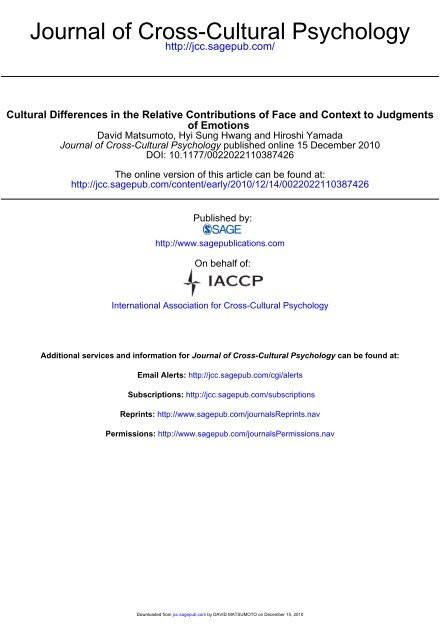
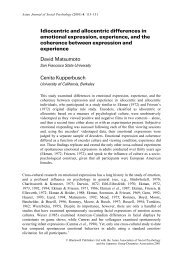
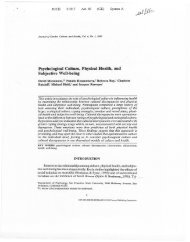
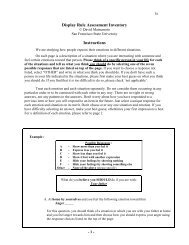
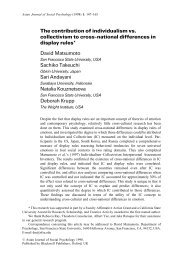
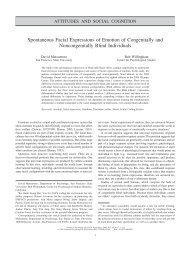
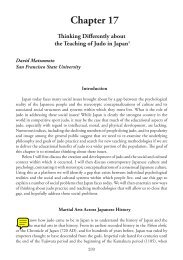
 Matsumoto, D., Yoo, S. H., & LeRoux, J. A. ... - David Matsumoto"
>
Matsumoto, D., Yoo, S. H., & LeRoux, J. A. ... - David Matsumoto"
>
